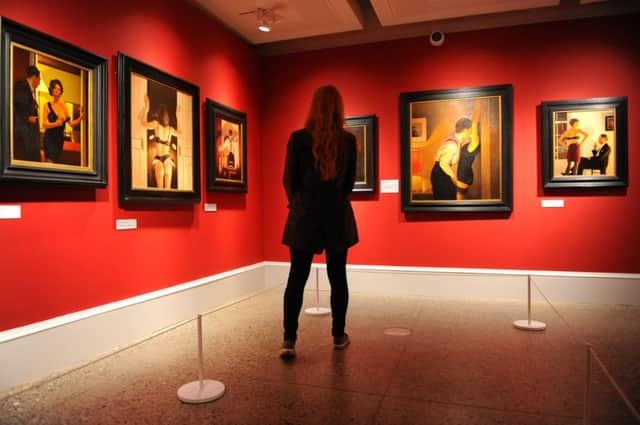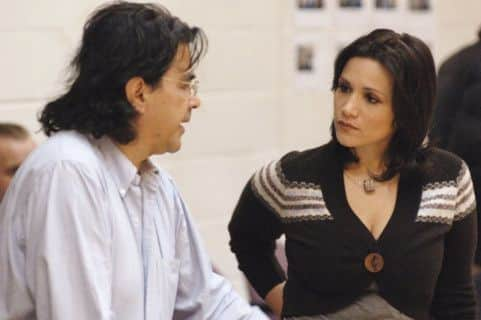Scotland’s landmark events of the year in culture


Moira Jeffrey on Jack Vettriano’s retrospective at Kelvingrove, Glasgow
‘Vettriano’s figures inhabit a weird, stalled, historical netherworld: flowered frocks and servants, fedoras, stockings and split skirts. It is the 1950s without poverty or sectarianism, the 1940s without the war. It is a world in which women have their mouths open to smoke or apply scarlet lipstick, but are entirely voiceless.
Advertisement
Hide AdThe women in many of the paintings, if that’s what they are, rather than scrapbook outlines of unusually uniform female forms, are frozen in odd pre- or post-coital poses. They are not humans.


Real sex is messy, it makes us vulnerable as much as powerful and it brings with it unexpected things: love, humiliation, power, embarrassment, compassion and familial ties. There is no compassion here. While the females in Vettriano’s “erotic paintings”, embarrassingly corralled in a red-walled corridor, take off their clothes, spread their legs, raise their bottoms for the men in the pictures and are groped in the crotch, the male figures, whom we might suspect by the facial resemblance are occasionally the artist’s own avatar, never get their kit off either literally or emotionally. This is image-making and exhibition-making that is dour and risk averse, but it is also deeply unpleasant: a miserably reductive view of men and a dangerously crude view of women. It is horrible. I want no part of a world that declares it snobbery to say that out loud.”
Joyce McMillan on Ciara at the Traverse Theatre, Edinburgh
‘As everyone who knows and loves the city can tell you, there is an edge to Glasgow’s famous warmth, and to its chatty curiosity about strangers. For as David Harrower’s heroine Ciara observes, in the brilliant new solo play, this is still a migrant city, full of competing tribes; a place where law and civic virtue can only take you so far, where family and group loyalties often matter more, and where a certain kind of crime is woven into the fabric of the city’s self-image.
So Ciara – played with magnificent passion, wit and quiet glamour by Blythe Duff – is a gallery owner, a patron of the arts. Yet her wealth comes, as she well knows, from the lifetime of organised crime pursued first by her father, Mick – “a great man”, as drunks in pubs still tell her. She has to live with the truth that as Mick’s daughter, she has been traded like a commodity all her life, just as she trades in artists’ lives now. There’s something about gender here, and something about Glasgow; but also something about civilisation and law itself, its fragility, its myths, its endless vulnerability.”
Fiona Shepherd on David Bowie’s comeback album, The Next Day
‘Now that we have the big reveal, it is apparent that the elegant languor and melancholy tone of the gorgeous comeback single Where Are We Now? is no representation of the rest of the album, which mostly jumps off the blocks with vigour and vitality. Bowie’s legions of fans will have fun unpicking the many nods to his own music and legend and the wider cultural references with which this album is liberally laced, such as the mentions of his old Berlin hangouts in Where Are We Now?, the debt You Feel So Lonely You Could Die owes to Five Years and the namechecks for Joan Baez, Brigitte Bardot and the blues song Tobacco Road, as well as the wholly unexpected appropriation of the melody from The Shadows’ Apache on How Does The Grass Grow?
Advertisement
Hide AdSonically, much of The Next Day is a twisted treat in the vein of Lodger and Scary Monsters. Dirty Boys is a song from the red light district, with its illicit imagery and sleazy sax on the prowl. Love Is Lost issues a dire you-can-run-but-you-can’t-hide warning over foreboding, discordant organ, an ominous backing chorus of Bowies and distant squalls of guitar.
This may just be the winning frisson that Bowie and producer Tony Visconti happen to create when they hit a studio, but they certainly know which buttons to push in order to trigger that intrinsic bliss and speak to the fans in familiar, yet inventive, tones.”
Alistair Harkness on Filth
Advertisement
Hide Ad‘Director Jon S Baird hasn’t quite solved the problem of how to transform Irvine Welsh’s book into something that is more than a collection of desperate-to-shock scenes. Characters and concepts too often fall by the wayside and in keeping with the Christmas setting, the grotesquery frequently feels a little bit too broad and panto-like. Some of that is deliberate, of course, but where films such as Nicolas Winding Refn’s Bronson and Werner Herzog’s Bad Lieutenant: Port of Call New Orleans (both touchstones for Filth) are gleefully and genuinely transgressive in depicting reprehensible behaviour, Filth just seems a little bit naughty by comparison.
This approach also makes the film curiously unmoored in other ways. Welsh’s novel was set in the late 1990s, but as Danny Boyle and Co did with the film version of the 1980s-set Trainspotting, Baird avoids too many specific period signifiers. The world of Filth is a world with wall-mounted flat screen TVs but old rotary dial telephones, a world in which Frank Sidebottom remains a current pop cultural reference point, yet peroxide-haired gangs (led by Martin Compston) roam the city’s underpasses like the droogs from A Clockwork Orange as re-imagined by Luc Besson. This gives Filth a weird, retro-futuristic feel. Where Trainspotting felt thoroughly plugged into the cultural and political zeitgeist, Filth seems curiously unengaged with the world around it.”
Ken Walton on turmoil at Scottish Opera
‘Was Emmanuel Joel-Hornak a good appointment as music director in the first place? We’ll never really know. He wasn’t a major catch, despite the fact the Scottish Opera Orchestra felt good and inspired by him on the previous occasions he had conducted. He was an experienced, jobbing conductor. Was the Frenchman duped into thinking he would have more power than would be the case, or naive in failing to ask the right questions? Anyway, it’s all gone sour, and what are we left with? A company that is artistically rudderless, which is seen as dysfunctional in the industry, and as a result will have endless problems recruiting any music/artistic director worth his or her salt. As one senior Scottish musical figure pointed out, there’s nothing more powerful in the musical world than the operatic grapevine. I imagine the Scottish Government – which funds SO to the annual tune of over £8 million – is remaining mute simply because, to give general director Alex Reedijk his due, he has taken the formerly cash-stricken company to a position where it balances the books. So in purely economic terms, today’s SO is a success story, not the political inconvenience it once was. But wouldn’t you think the question any SNP politician would be asking, a year from the referendum, is this: what credibility as a statement of Scotland’s cultural identity would SO have in a world where Scotland was an independent nation?”
Duncan Macmillan on Allan Ramsay at the Hunterian
‘We have not been so good at marking anniversaries of our great artists. The bicentenary of Raeburn’s death passed almost without notice, likewise the centenary of McTaggart’s, but 13 October will be the tercentenary of Allan Ramsay’s birth and the Hunterian in Glasgow is marking it with Allan Ramsay: Portraits of the Enlightenment.
Of all our great artists, Ramsay is the most fitting to celebrate. The reason is implicit in the exhibition subtitle, “Portraits of the Enlightenment”. Ramsay belonged at the centre of the Enlightenment and so, of the history of Scottish art. David Hume’s Treatise of Human Nature defined the Enlightenment and set its agenda. Ramsay and Hume were friends. Ramsay was one of the finest draughtsmen of the age, but his skill was not just superficial dexterity. Drawing for him was an instrument of intellectual enquiry, a vehicle of exchange between the mind and the world around it. His hand is guided, not by the simple need to enumerate facts, but by sympathy and imagination. It is there his art meets Hume’s philosophy. The Enlightenment did not signify the triumph of reason, but recognition of its limitations; reason is no more than a tool; without the imagination to guide and control it, it is useless.”